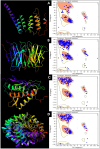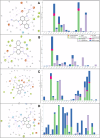Evaluating the multitargeted potency of Pixuvri against cell cycle regulation proteins in cervical cancer
- PMID: 40519296
- PMCID: PMC12163068
- DOI: 10.3389/fonc.2025.1598883
Evaluating the multitargeted potency of Pixuvri against cell cycle regulation proteins in cervical cancer
Abstract
Cervical cancer, primarily caused by persistent infection with high-risk human papillomavirus strains, leads to abnormal cell growth in the cervix. Globally, it accounts for over 600,000 new cases and 340,000 deaths annually, with the highest burden in low- and middle-income countries due to limited screening and vaccination. Early detection is challenging as initial stages are asymptomatic, while advanced cases are challenging to treat. Current options, including surgery, radiotherapy, and chemotherapy, face issues like toxicity, limited efficacy, recurrence, and drug resistance caused by tumor heterogeneity and adaptive mechanisms. Multitargeted drug design offers a solution by modulating multiple cancer pathways, enhancing efficacy, minimizing resistance, and reducing side effects. In this study, we screened Selleckchem approved library against cervical cancer proteins that regulate the cell cycle, particularly during mitosis and cell division (PDBIDs: 2VFX, 2WVI, 3KND, 4N14) using HTVS, SP, and XP docking followed by MMGBSA post-processing. Pixuvri (Pixantrone Maleate) emerged as the top candidate with docking scores of -5.234 to -9.218 kcal/mol and MMGBSA scores of -39.22 to -53.87 kcal/mol. Pixuvri is approved for non-Hodgkin lymphoma and exhibits minimal cardiotoxicity compared to anthracyclines. Interaction fingerprints highlighted key residues (4GLN, 4GLU, 3TRP), while pharmacokinetics, DFT computations, and WaterMap hydration site analysis supported its potential. Molecular dynamics (100 ns, NVT ensemble at 300K) validated stability by deviation and fluctuation studies and found many interactions to stabilize the complex, with binding free energy computations confirming its affinity. While the results support Pixuvri's repurposing for cervical cancer, experimental validation is essential for clinical application.
Keywords: Pixuvri; WaterMap; cervical cancer; drug resistance; multitargeted drugs.
Copyright © 2025 Alshehri, Alahdal, Aloqbi, Shakoori, Sindi, Bagadood, Alsaffar, Alobaidy, Alrabiah, Khursheed and Tuwaijri.
Conflict of interest statement
The authors declare that the research was conducted in the absence of any commercial or financial relationships that could be construed as a potential conflict of interest.
Figures









References
-
- Allanson ER, Schmeler KM. Preventing cervical cancer globally: are we making progress? Cancer Prev Res. (2021) 14:1055–60. - PubMed
-
- Ahmad S, Sayeed S, Bano N, Sheikh K, Raza K. In-silico analysis reveals Quinic acid as a multitargeted inhibitor against cervical cancer. J Biomolecular Structure Dynamics. (2022), 1–17. - PubMed
LinkOut - more resources
Full Text Sources
Miscellaneous

